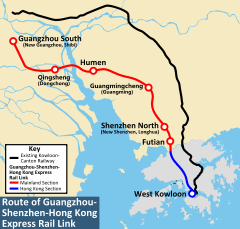Shiziyang Tunnel
The Shiziyang Tunnel is a high-speed railway tunnel under Shiziyang the northern part of the Pearl River estuary in China.[1]

Route
The 10.8 km long tunnel is part of a 140 km high-speed line from Guangzhou to Shenzhen and Hong Kong. It is designed for speeds of up to 350 km/h (usually 250 km/h in operation) - the fastest underwater tunnel in the world.[2] as well as being China's longest underwater tunnel.[3] This allows rail journeys between Guangzhou and Hong Kong to take only 40 minutes – much faster than the previous 2-hour journey. The Guangzhou-Shenzhen-Hong Kong express rail link is part of a broader expansion of high-speed rail in China; journeys from Beijing to Hong Kong will take only 8 hours.[4]
Construction
Construction began in November 2007, with a budget of CNY2.4 billion;[5] the tunnel was completed in 2011, and passenger services began on 26 December 2011.[4] Unusually, the tunnel boring machines were designed to be dismantled inside the tunnel.[5]
References
- "News in Brief". Railway Gazette. 16 April 2011. Retrieved 14 August 2011.
- "China completes construction of world's fastest underwater railway tunnel". 12 March 2011. Archived from the original on 31 May 2011. Retrieved 14 August 2011.
- "Study on Shiziyang Tunnel Engineering Geology and Shield Tunneling". 2010. Retrieved 14 August 2011.
- "Shiziyang underwater tunnel ready as part of High Speed Line to Hong Kong". HSL Zone. 15 March 2011. Archived from the original on 16 May 2011. Retrieved 14 August 2011.
- "Construction Starts at Shiziyang Tunnel in China". Archived from the original on 21 July 2011. Retrieved 14 August 2011.